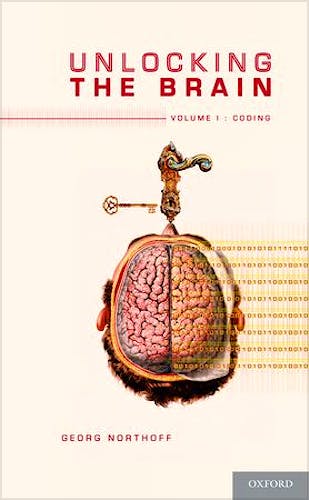

No hay productos en el carrito



Unlocking the Brain, Vol. I: Coding
Northoff, G.
1ª Edición Enero 2014
Inglés
Tapa dura
352 pags
2000 gr
16 x 24 x null cm
ISBN 9780199826988
Editorial OXFORD
LIBRO IMPRESO
-5%
128,38 €121,96 €IVA incluido
123,44 €117,27 €IVA no incluido
Recíbelo en un plazo de
2 - 3 semanas
About this book
- One of the first volumes to explore the linkage between coding and consciousness.
- Presents a novel characterization of the brain's intrinsic activity in terms of its spatiotemporal structure.
- Provides a unique transdisciplinary approach between neuroscience, psychiatry, and philosophy.
Neuroscience has made considerable progress in figuring out how the brain works. We know much about the molecular-genetic and biochemical underpinnings of sensory and motor functions, and recent neuroimaging work has opened the door to investigating the neural underpinnings of higher-order cognitive functions, such as memory, attention, and even free will. In these types of investigations, researchers apply specific stimuli to induce neural activity in the brain and look for the function in question. However, there may be more to the brain and its neuronal states than the changes in activity we induce by applying particular external stimuli.
In Volume 1 of Unlocking the Brain, Georg Northoff presents his argument for how the brain must code the relationship between its resting state activity and stimulus-induced activity in order to enable and predispose mental states and consciousness. By presupposing such a basic sense of neural code, the author ventures into different territories and fields of current neuroscience, including a comprehensive exploration of the features of resting state activity as distinguishable from and stimulus-induced activity; sparse coding and predictive coding; and spatial and temporal features of the resting state itself. This yields a unique and novel picture of the brain, and will have a major and lasting impact on neuroscientists working in neuroscience, psychiatry, and related fields.
Readership: Neuroscientists, philosophers, psychiatrists, computation researchers, biologists, as well as undergraduate, graduate, and postgraduate students interested in these areas.
Table of contents
List of Figures
Preface
Introduction to Volume I
Part I: Coding Extrinsic Stimuli: From the Environment to the Brain
Chapter 1: Sparse Coding and Natural Statistics
Chapter 2: Sparse Coding and Neural Inhibition
Chapter 3: Sparse Coding on a Regional Level
Part II: Coding Intrinsic Activity: From the Brain to the Brain
Chapter 4: Spatial Structure of Intrinsic Activity
Chapter 5: Temporal Structure of Intrinsic Activity
Chapter 6: Sparse Coding of Intrinsic Activity
Part III: Coding Intrinsic Predictions: From the Brain to Anticipation
Chapter 7: Predictive Coding and Difference-Based Coding
Chapter 8: Predictive Coding and Social and Vegetative Statistics
Chapter 9: Predictive Coding and the Brain's Intrinsic Activity
Part IV: Coding Extrinsic Activity: From the Brain to the Environment
Chapter 10: Stimulus-Stimulus Interaction and Neural Coding
Chapter 11: Rest-Stimulus Interaction and Difference-Based Coding
Chapter 12: Rest-Stimulus Interaction and GABA
Epilogue: A Quick Guide to the Brain
Appendix: Theoretical Reflections
Appendix I: Neuro-Empirical Remark: Resting State Activity versus Stimulus-Induced
Activity and the Continuity Hypothesis
Appendix II: Neuro-Theoretical Remark: Localizationism versus Holism
Appendix III: Neuro-Conceptual Remar: Concept of <"Difference>"
Appendix IV: Neuro-Epistemological Remark: Brain versus Observer
References
Index
© 2025 Axón Librería S.L.
2.149.0